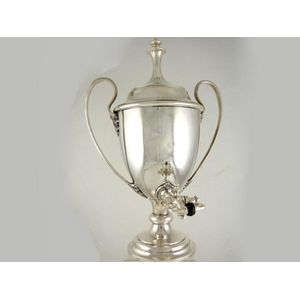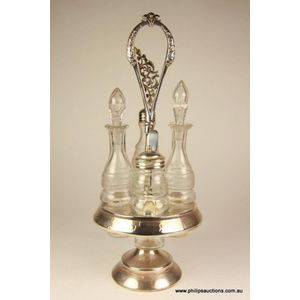Late Victorian Silver Plated Cruet Set with Bottles and Pot
You must be a subscriber, and be logged in to view price and dealer details.
Subscribe Now to view actual auction price for this item
When you subscribe, you have the option of setting the currency in which to display prices to $Au, $US, $NZ or Stg.
- Ep / Epns - The abbreviation for electroplated and electroplated nickel silver, that is, silver plate.
The body of the piece is made of a common metal such as copper, and electroplating involves placing an extremely thin layer of silver on the surface of the piece. The resulting silver content is very small.
Unlike solid silver items, there is minimal underlying scrap value, and the value of such pieces is based on the quality, design and construction of the piece. - Circa - A Latin term meaning 'about', often used in the antique trade to give an approximate date for the piece, usually considered to be five years on either side of the circa year. Thus, circa 1900 means the piece was made about 1900, probably between 1895 and 1905. The expression is sometimes abbreviated to c.1900.
- Bevel / Chamfer - In furniture making, a chamfered corner refers to a technique used to create a smooth, angled edge on the corner of a piece of furniture. This is typically done by cutting away a small portion of the corner at an angle, typically 45 degrees, creating a diagonal edge, rather than a sharp 90-degree angle. This technique can be used on various parts of a piece of furniture such as table legs, drawer fronts, or door frames. Chamfering can add visual interest to a piece and can help to soften the overall look of a piece of furniture. It is often used in conjunction with other techniques, such as rounding edges or using contrasting wood species to create a more elegant, sophisticated look. Chamfering is a simple way to add a touch of elegance to a piece of furniture and it is a common technique used by furniture makers.
- Victorian Period - The Victorian period of furniture and decorative arts design covers the reign of Queen Victoria from 1837 to 1901. There was not one dominant style of furniture in the Victorian period. Designers used and modified many historical styles such as Gothic, Tudor, Elizabethan, English Rococo, Neoclassical and others, although use of some styles, such as English Rococo and Gothic tended to dominate the furniture manufacture of the period.
The Victorian period was preceded by the Regency and William IV periods, and followed by the Edwardian period, named for Edward VII (1841 ? 1910) who was King of the United Kingdom and the British Dominions and Emperor of India for the brief period from 1901 until his death in 1910.
This item has been included into following indexes:
Visually similar items

A fine Austrian Counterweight cast bronze table lamp, circa 1900, with a waisted and shaped triangular stem with classical scrolls and anthemion detailing to a circular socle and a similarly decorated spreading base, the pivoting double scroll arm with a t

Pair of antique candlesticks, impressed marks to base, each approx 19 cm high (2)

An Edwardian plated tea urn with a domed cover, tap and reeded handles in Adams style. Maker: Walker and Hall. 50 cm high

A Victorian glass decanter, 19th century, the slightly waisted and shouldered decanter with distinctive shaped ribs below a conical collar and a faceted neck, with a conforming mushroom stopper. Height 32 cm
